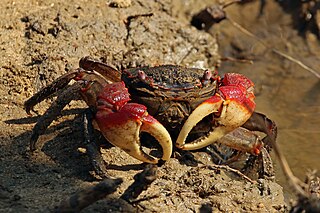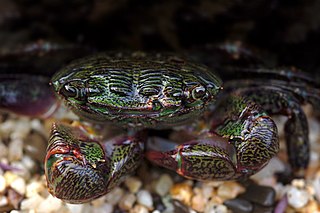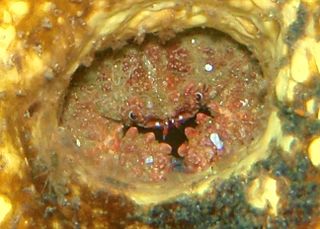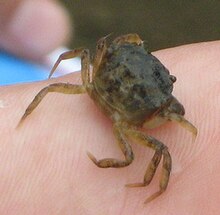
A fiddler crab, sometimes known as a calling crab, may be any of more than one hundred species of semiterrestrial marine crabs in the family Ocypodidae. A smaller number of ghost crab and mangrove crab species are also found in the family Ocypodidae. This entire group is composed of small crabs, the largest being slightly over two inches (5 cm) across. Fiddler crabs are found along sea beaches and brackish intertidal mud flats, lagoons, swamps, and various other types of brackish or salt-water wetlands. Fiddler crabs are most well known for their sexually dimorphic claws; the males' major claw is much larger than the minor claw, while the females' claws are both the same size.

Xanthidae is a family of crabs known as gorilla crabs, mud crabs, pebble crabs or rubble crabs. Xanthid crabs are often brightly coloured and are highly poisonous, containing toxins which are not destroyed by cooking and for which no antidote is known. The toxins are similar to the tetrodotoxin and saxitoxin produced by puffer fish, and may be produced by bacteria in the genus Vibrio living in symbiosis with the crabs, mostly V. alginolyticus and V. parahaemolyticus.

Portunidae is a family of crabs which contains the swimming crabs.

Macrophthalmus is a genus of crabs which are widespread across the Indo-Pacific. It contains the following species :

Cryptochiridae is a family of crabs known commonly as gall crabs or coral gall crabs. They live inside dwellings in corals and cause the formation of galls in the coral structure. The family is currently placed in its own superfamily, Cryptochiroidea.

Discoplax is a genus of terrestrial crabs. It is very closely related to the genus Cardisoma.

Pseudothelphusidae is a family of freshwater crabs found chiefly in mountain streams in the Neotropics. They are believed to have originated in the Greater Antilles and then crossed to Central America via a Pliocene land bridge.

The Sesarmidae are a family of crabs, previously included in the Grapsidae by many authors. Several species, namely in Geosesarma, Metopaulias, and Sesarma, are true terrestrial crabs. They do not need to return to the sea even for breeding.

Sesarma is a genus of terrestrial crabs endemic to the Americas.

Pilumnoidea is a superfamily of crabs, whose members were previously included in the Xanthoidea. The three families are unified by the free articulation of all the segments of the male crab's abdomen and by the form of the gonopods. The earliest fossils assigned to this group are of Eocene age.

Actumnus is a genus of crabs in the family Pilumnidae. Alongside the 28 extant species, it has a fossil record extending back into the Miocene.

Pachygrapsus is a genus of small shore crabs. Recent genetic data suggest this genus to be possibly polyphyletic.

Xantho is a genus of crabs in the family Xanthidae, containing five extant species, all restricted to the north-east Atlantic Ocean and Mediterranean Sea, although Xantho granulicarpis is not universally recognised as a separate species from Xantho hydrophilus:

Actaea is a genus of crabs in the family Xanthidae, containing the following species:

Glyptoxanthus is a genus of crabs in the family Xanthidae, containing eight species. It was originally erected by Alphonse Milne-Edwards in 1879 for six species previously placed in the genus Actaea and elsewhere. Although previously included in subfamily Euxanthinae, the genus has a quite distinct morphology from other genera in that group, and was placed in 2011 in the new, monotypic subfamily, Glyptoxanthinae by Jose Christopher Mendoza and Danièle Guinot.

Dyspanopeus sayi is a species of mud crab that is native to the Atlantic coast of North America. It has also become established outside its native range, living in Swansea Docks since 1960, the Mediterranean Sea since the 1970s, the North Sea since 2007 and the Black Sea since 2010. It can reach a carapace width of 20 mm (0.8 in), and has black tips to its unequal claws. It feeds on bivalves and barnacles, and is in turn eaten by predators including the Atlantic blue crab, Callinectes sapidus. Eggs are produced from spring to autumn, the offspring reach sexual maturity the following summer, and individuals can live for up to two years. The closest relative of D. sayi is D. texanus, which lives in the Gulf of Mexico; the two species differ in subtle features of the genitalia and the last pair of walking legs.

Dyspanopeus is a genus of crabs in the family Xanthoidea, comprising two species:

Pilumnoides is a genus of crabs in the family Pilumnoididae. The genus was erected by Hippolyte Lucas in 1844. It contains the following species:

Hirsutodynomene is a genus of crabs in the family Dynomenidae. All species in this genus except the newest one belonged to the genus Dynomene. These two genera form the subfamilia Dynomeninae. The type species of this genus is: Dynomene spinosa(Rathbun, 1911).

Leptuca is a genus of fiddler crabs belonging to the family Ocypodidae.




















